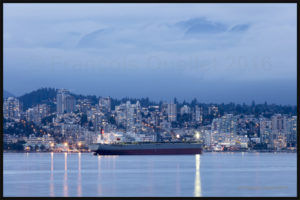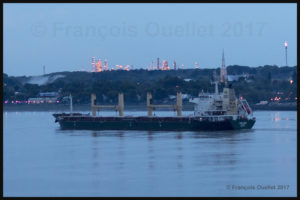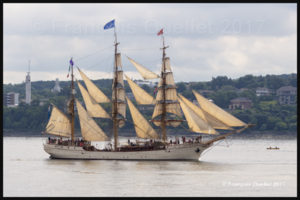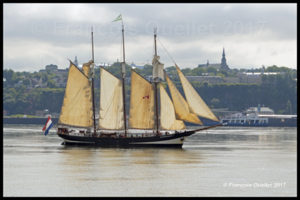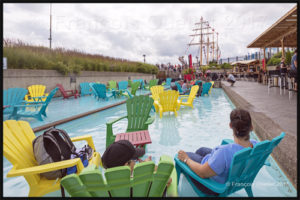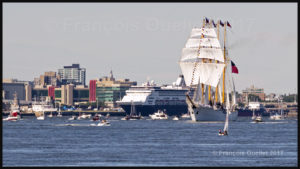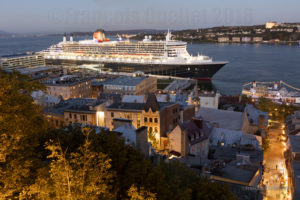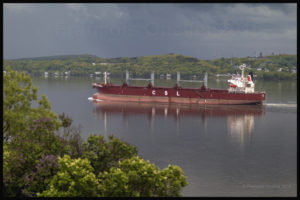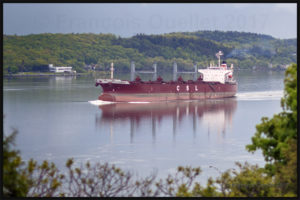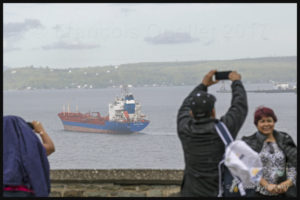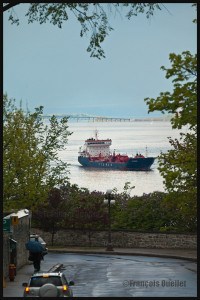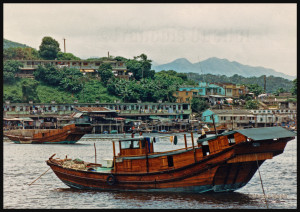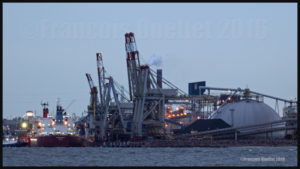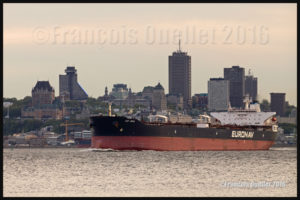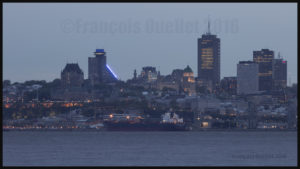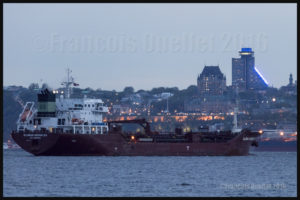The Corona Frontier ship in the Vancouver harbour
The picture above was taken during summer 2016 in the Vancouver harbour, in British Columbia. I chose that time of the day to take the picture since the light was at its best.
The calm winds allowed for a better reflection in the water. The rain, which had been falling almost all day, favored the presence of low clouds which eventually hid the mountains. It is nonetheless possible to still see part of the mountains at the top of the picture.
I used a Canon 5DSR full frame camera equipped with a Canon 70-200 f2.8L IS II USM telephoto lens. The aperture was set at F9 in order to optimize the photo’s sharpness.
The bulk carrier ship in the foreground is the Corona Frontier. It sails under the japanese flag and has its home port in Kobe. The vessel was built in 2000. The Corona Frontier’s draught is 13.7 meters and its gross tonnage is 48032 tons.
The Harlequin near Lévis and heading to Rouen, France
The picture above shows the Harlequin, a bulk carrier built in 2012 that has a 9.7 meter draught. It sails under the Cyprus convenience flag. On June 18th 2017, when the photo was taken, it was in front of the Jean Gaulin refinery in Lévis, Quebec, and was about to cross the Atlantic heading to Rouen, France. The Jean Gaulin refinery is Quebec’s largest refinery and ranks second in Canada when it comes to refining crude oil.
The photo was taken at 21:07, just before nightime. Since I was positioned on the highest floor of the Quai des Cageux wooden tower, there were constant vibrations associated with people going up and down the stairs. The tower’s movement combined with a moving vessel made the use of of tripod totally useless. It was thus necessary to make a handheld photo, which seriously increased the risk of a blurred picture considering the lack of light.
A Canon EF 85mm f/1.2 II USM fixed lens installed on a Canon 5DSR full frame camera helped to make a successful shot. The fact that this kind of lens requires very little light increases the photographer’s margin of manoeuver. It would obviously have been possible to increase the ISO to 6000 and more to compensate for the poor lighting, but that would have degraded the photo’s quality. The ISO was thus limited to 2000, with a shutter speed of 1/200 sec and a 1.6 aperture.
In order to limit the risk of a blurred picture, it was necessary to follow the movement of the ship with the camera. The closer one gets to immobilizing the ship in the viewfinder, the better the chances of a defined photo.
Since the ship was farther than it appears on the picture above, some cropping was mandatory to bring the vessel to a decent size. If the ISO had been too elevated to start with, the ensuing photographic grain would have been too big after the cropping and the quality of the picture would have suffered. With an ISO limited to 2000, the image kept a decent definition.
The vessels Europa and Impossible Dream in Quebec for the Tall Ships Regatta in 2017
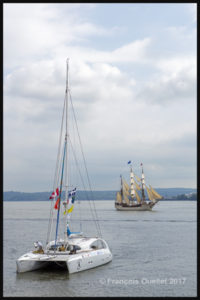
The picture above shows the catamaran « Impossible Dream » and the three masted vessel Europa arriving in Quebec for the Tall Ships Regatta 2017.
The Impossible Dream is a catamaran built in 2002 and designed to travel on the ocean. Its mission, as stated on the website Impossible Dream, is “to bring disabled and nondisabled people together in productive, collaborative endeavors ».
The Europa is sailing under the Netherlands flag. The crew was nice enough to use all the ship’s sails, even while the wind were not really favorable. That pleased the crowd and helped to achieve even better pictures. Since it was only 10h30 AM, the sails were lighted at an angle by the sun, which produced a more lively effect.
I elected to keep the small canoe and its passengers, at the right of the picture, in order to give an idea of the Europa’s scale.
The pictures were taken with a Canon 5DSR full frame camera.
The schooner Oosterschelde arriving in Quebec in 2017
The picture above shows the tree-masted schooner Oosterschelde, from Netherlands, arriving in Quebec in the morning of July 18th 2017, during the Tall Ships Regatta 2017. In the background is the city of Lévis.
The picture was taken with a Canon 5DSR full-frame camera equipped with a Canon 24-70mm f/2.8L USM.
The Chilean sailboat Esmeralda at the Tall Ships Regatta 2017 in Quebec City
In July 2017, the four masted Chilean sailboat Esmeralda arrived in Quebec City for the Tall Ships Regatta 2017. The arrival was quite spectacular, as the whole crew sang together for several minutes for the people standing along the pier.
In order to avoid any distraction, the full frame picture has been taken in the portrait mode and the cropping was tight enough to bring forward the crew members standing up high away on the masts.
The picture below offers another point of view of the sailboat masts but this time the importance is given to the colored chairs directly installed in water, allowing the tourists to cool down during a particularly hot summer day. The wide angle lens used for the shot was a Canon 14mm f/2.8L. Two diagonal lines created by the pool in the foreground progressively meet with each other in the distance, in front of the sailboat.
When the Tall Ships Regatta 2017 ended, several small boats approached the Esmeralda and other sailboats to slowly travel with them from Quebec City until they cleared île d’Orléans. In the picture below, you can see the cruise ship Maasdam, which has been repositioned to a new pier in the Port of Quebec in order to accomodate the sailboats.
In the picture below, the sailboat Esmeralda his heading towards the north of île d’Orléans as the final parade is completed. On the left, you can see the Château Frontenac and, directly behind, the Hotel Le Concorde Québec, with in its upper ring a revolving restaurant offering a superb view of Quebec City. The hand held photo was taken from île d’Orléans with a Canon EF 70-200mm f/2.8L IS II USM telephoto lens. This lens is equipped with an integrated stabilizer.
It would nonetheless have been quite difficult to succeed with such an important cropping without the performance of the 50.6 megapixel full frame sensor used in the Canon 5DSR. Considering the great distance over water that is present between the camera and the sailboat, it is possible that you notice a mirage effect, even with the small picture presented here.
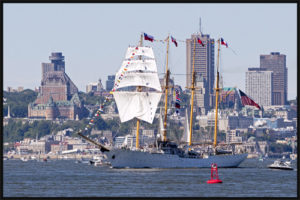
I thought the crew would use all of the sailboat’s sails once passed île d’Orléans, but it was not the case. The picture below was taken from the top of a wooden tower installed at the north east extremity of île d’Orléans, while the Esmeralda is still navigating using its engine.
Even without the sails, the photographic composition benefited from a yellow field, a merchant ship and a lively horizon line showing the Appalachian mountains. No tripods were used for the shot as the wooden tower was constantly moving. The telephoto lens used was a Canon EF 70-200mm f/2.8L IS II USM and a slight cropping was necessary.
An approximative rule of thirds is behind the composition of the photo : you can imagine three fictive horizontal lines dividing the frame. The sailboat also finds itself on one of the rule of thirds vertical line on the right.
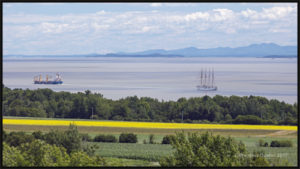
The Queen Mary 2 in Old Quebec
The Queen Mary 2 comes twice a year in the Quebec Harbour during the autumn. It obviously always attracts a lot of onlookers. The vessel carries 2620 passengers who are prompt to visit Old Quebec upon arrival.
In order to take a picture of this superb ship and the architecture of Old Quebec’s houses, it was worth waiting until evening, when the colours were more subtle. I could have chosen to do a close-up of the Queen Mary 2, but by doing so the photo would have lost some of its dynamism since the quartier Petit-Champlain’s alleys and its pedestrians would have been absent from the scene.
There is only a small portion of the sky visible in the picture and this is voluntarily since it does not present any interesting details, especially when compared with the rest of the scenery. The front of the Queen Mary 2 has wilfully been located in the superior right corner of the photo since it is toward this part of the image that the eye ends its initial inspection.
There were quite a number of viewers installed on the Dufferin Terrace, most with a portable camera, trying to capture the scene. All those onlookers and photographers constantly moving on the wooden terrace were nevertheless creating vibrations: a tripod, usually the perfect tool to prevent any shaking of the camera, was only useful here providing that there was a shorter exposure time. The ISO had to be increased accordingly to respect the shorter exposure and avoid a blurred picture at low speed.
Still, the photo taken with a Canon 5DSR full-frame camera successfully portrays the mood in Old Quebec on that evening of autumn 2016.
The bulk carrier Ferbec by Quebec City in 2017
The picture above shows the Bulk Carrier Ferbec. It belongs to CSL (Canada Steamship Lines). It was built in 2002 and regularly travels between Sorel and the North Shore to carry ore. It is seen here in front of Quebec in May 2017, with Lévis in the background.
The picture was taken using a Canon 5DSR equipped with a Canon EF 85mm f/1.2L II USM fixed lens.
Instead of taking only a picture of the vessel, I thought it would be more interesting to keep it at a distance and capture the scene when I would see, in the viewfinder of the camera, vegetation partly surrounding the ship.
Weather was quite unstable around Quebec. On the north shore, the sky was mostly covered by a thin veil of cirrus clouds while on the south shore were numerous towering cumulus with rain showers.
Since there were only thin clouds on the north shore of the seaway, a part of the sunlight directly hit the side of the ship, adding some dynamism to the scenery.
Surprisingly, there was only a very light wind directly over the seaway, which helped improve the ship’s reflection in the water. All the elements were now present to capture a souvenir shot of the Ferbec in front of Quebec City.
Merchant navy vessel in the Juan de Fuca Strait in British-Columbia
Photographers know that the most interesting hours of the day are either early in the morning or late at night, but before nighttime. These periods are ideal for subtle colors and very atmospheric shots.
The Vancouver Island coast offers absolutely everything to attract many categories of photographers: the wildlife, the mist over water bodies in the morning or late at night and the mountains that are visible almost everywhere.
Travelling through British Columbia, I noticed the great number of merchant navy vessels passing through the Juan de Fuca Strait. But to try to photograph them during daytime would only have given average pictures. Waking up early to get the right picture is never easy, but it always gives interesting results.
The only problem with regards to ship photography is that the latter often navigate quite far from the photographer, thus becoming tiny uninteresting dots on a picture. However, the Canon 5DSR camera and its 50.6 megapixels full-frame sensor solve that problem: new experiments are then possible
.
The scenery above was shot from a beach in Victoria, very early in the morning. It was mandatory to ensure of the total immobility of the camera since some serious cropping would be needed later on in order to significantly enlarge the ship. The slightest vibration would have been amplified through enlargment and the picture would have been useless.
Here is the method that was used: the ISO was set on 250, the tripod planted on the beach (but not in the soft sand part where the tripod could have moved a little during the photo session). Moreover, the remote trigger was used, as well as the mirror lock-up function. In order to achieve an optimal focus, the latter was done manually using Liveview with a 16X enlargment.
A Canon 70-200 f2.8L IS II USM telephoto lens was installed on the camera, with a 200mm focal setting. A ND graduated filter was installed to compensate for the rising sun’s brighter light behind the mountains. Being early on the beach also allowed for a minimal wind speed, limiting even more any tripod vibrations. I tried several shots and decided to keep the one with a bird in the scenery, so as to add a touch of life to the scenery.
The Havelstern between Quebec City and Lévis
The Havelstern is a chemical tanker sailing under Canadian flag which was built in 1994. Its draught is of 8.5 meters. It is photographed here on June 3rd 2017 in front of Quebec City, with Lévis in the background, heading to Point Tupper in Nova Scotia, Canada.
Several vessels are visible in the picture above. In the foreground, it is possible to see the two chimneys of the Louis Joliet, a boat essentially used for tourist excursions. Then there is one of the two ferries constantly traveling between the south and north shore of St. Lawrence Seaway between Lévis and Quebec City.
The small boat riding by the Havelstern is used to carry one of the St. Lawrence Seaway pilots. A pilot who masters the navigation specifications on this part of the seaway boards the ship and takes control until he can transfer the control to another pilot farther down the seaway ( Pilotes du St-Laurent ). In the background is the second ferry used to carry passengers and cars from one shore to the other.
The full-frame camera used to take the pictures was a Canon 5DSR equipped with a Canon EF 70-200mm f/2.8L IS II USM lens. With a 5.0 aperture and the ISO set at 200, the shutter speed allowed was 1/1000 sec.
While the tourists are having fun in Quebec City, the picture above shows the Havelstern heading to Île d’Orléans in a rain shower.
The picture below represents the Havelstern making a wide turn to navigate around the southern portion of Île d’Orléans. The ship was quite far away and some serious cropping would have to be done in order to enlarge the image. In order to get a picture that would not be blurred, I had to increase the shutter speed a bit.
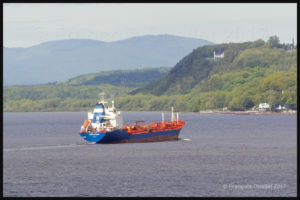
The ISO was adjusted to 200 and the focal length was set to 200mm. The aperture was only 4.0, allowing a shutter speed of 1/2500 sec.
The YM Saturn approaching Québec
The YM Saturn is a merchant navy ship carrying chemical products. The owner is Yilmar Shipping and Trading, from Istanbul, Turkey. It was built in 2007 and uses the Malt flag throughout its international trips. You can see it here, approaching Quebec City, in 2014. In the background, the Île d’Orléans bridge is visible.
In order to frame the vessel differently during its approach toward Quebec City, I positioned myself at the corner of Buade Street, in Old Quebec. The street and surroundings trees and branches offered a natural frame in which it became possible to position the ship. Weather conditions were constantly changing, with rain showers that allowed to get a more lively street. The ship was far away, but the compressed perspective effect created by a Canon 70-200mm 2.8 coupled with a 2X extender gives a feeling of proximity.
The Chinese junks of Tai Po
This picture was taken with a Pentax SF1 camera during a one month trip in the area of Hong-Kong. Other pictures relating to this 1990 Asian trip are available in my photo gallery sections under the title “Asia”.
The period when this picture of the Chinese junks in Tai Po was captured corresponds exactly to one year after the 1989 Tiananmen Square events. The South China Morning Post had written that about 100,000 persons had marched to commemorate the tragedy. I could even see the crowd from my seat in the Cathay Pacific Boeing 747-200 when we overflew Hong Kong for the final approach towards the Kaï Tak airport.
I used some time to travel on the South China sea and when our ferry started to navigate between islands, I saw those beautiful wooden junks and captured the scene.
The Bassin Louise in Quebec City
In order to give an impression of a very busy day in the Port of Quebec, during Spring 2015, I used a Canon 70-200 f2.8L IS II USM. A zoom is very useful to achieve some special effect in photography.
The apparent chaos in the photo is created by numerous details: first of all, the viewer has to read numerous words that have very different impacts on him: POLICE, CANADA, OCEAN, Sécurité Maritime, Maritime Security, GRC, RCMP, MEGA, Sea Tel, and part of the word Coast.
Secondly, there are numerous vertical lines of all sizes that interfere with multiple horizontal lines. The BUNGE silos, in the background, are themselves vertical lines, but much larger than the others.
The compressed perspective obtained through the use of a zoom gives the viewer a feeling that all the objects are close to each other. We are left wondering how the captain can manoeuver his boat with such little space available.
What is really happening in the scene: it is a very quiet day, where almost everything is immobile. There is only one boat that has started to move and the captain has all the space needed to leave the Bassin Louise and head toward the St-Lawrence Seaway without being concerned with any serious obstacle.
Few ships photographed in front of Quebec City in 2016
Here are a few photos taken during the month of May 2016 using a Canon 5DSR camera equipped with a Canon 70-200 f2.8L IS II USM telephoto lens. I was on île d’Orléans for the photo session, near the Horatio Walker promenade in Sainte-Pétronille.
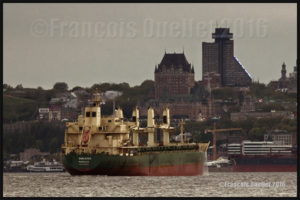
The picture above shows the vessel Shelduck flying the Liberian flag. It just crossed the narrow channel between île d’Orléans and Levis. This ship, built in 2012, is a bulk carrier. In the background it is possible to see Quebec City, with the Château Frontenac and the Hotel Le Concorde Quebec.
The photo below shows the Silver Carla (Majuro), a tanker used to carry oil and chemical products. It is moored at the Quebec harbour installations. The ship was built in 2014 and sails using the Marshall Islands flag of convenience.
In the picture below, the tanker Cap Jean, property of Euronav, is approaching île d’Orléans. This tanker was initially supposed to be named St. Jean but the name’s religious connotation could have caused problems in some parts of world. The name Cap Jean was thus chosen.
The photo below, also taken from île d’Orléans, offers an interesting view of Quebec City just before nightime. The Hotel Le Concorde Quebec’s new lighting system is visible in the distance. In the foreground, you can see the ship Laurentia Desgagnés.
Below, the ship Nilufer Sultan is heading towards Quebec harbour. Built in 2008, this oil tanker also uses the Marshall Islands flag of convenience.
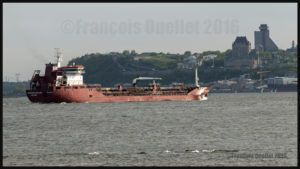
The photo below shows the tanker Sloman Herakles, normally based in St. John’s, Canada. It sails under the Antigua and Barbuda flag and is heading to Sarnia, Ontario.
The two photos below show the container ship Toronto Express, property of the Hapag Lloyd Company. I chose to transform the first picture in black and white since the ship did not contrast enough with the background in the colored picture. It is actually slightly inclined since it is turning towards the right while approaching île d’Orléans. On the next picture, we can see in the background the smoking chimney of the Papiers White Birch Company, formerly called Daïshowa and later Stadacona.


Below is the chemical tanker Mayaro (Japan) arriving near Quebec City in May 2016.
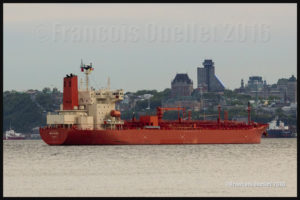
Taking pictures in the evening
Trying to take pictures of moving ships in the evening, using the smallest possible ISO, forces a photographer to use a tripod, a remote trigger and the camera’s mirror lock-up function to reduce vibrations. Ideally, it is best to find a spot where the tripod will be protected from the wind while ensuring that the camera’s strap is not moving at all. There is no need to use a polarizing filter at this time of the day: that would only be detrimental to the photo.
The Canon 5DSR DSLR full frame camera allows the photographer to take a picture in two steps, reducing even more the possibility of secondary vibrations. First, the mirror is lifted up. Then, two seconds later, the photo is finally taken. For a sharper image, it is best to use the Liveview function with a 16X enlargement and do a manual focus adjustment.
Risks associated with photography!
On île d’Orléans, many visitors use the surroundings banks to let their dog roam freely. This can cause a problem as the animal sometimes perceives the photographer and his photographic equipment as a potential threat to a master that it must protect… You will have been advised!
